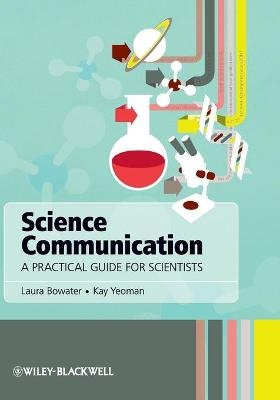
Science Communication
Wiley-Blackwell (Verlag)
978-1-119-99312-4 (ISBN)
Designed to help the novice scientist get started with science communication, this unique guide begins with a short history of science communication before discussing the design and delivery of an effective engagement event. Along with numerous case studies written by highly regarded international contributors, the book discusses how to approach face-to-face science communication and engagement activities with the public while providing tips to avoid potential pitfalls.
This book has been written for scientists at all stages of their career, including undergraduates and postgraduates wishing to engage with effective science communication for the first time, or looking to develop their science communication portfolio.
Laura Bowater has recently been awarded a Public and Community Engagement Award from CUE (Community University Engagement) East, the Beacon of Excellence in the Eastern region. Kay Yeoman's work has been recognized by a nomination for the Royal Society Kohn Award in 2008 and also a Public and Community Engagement Award from CUE East the Beacon of Excellence in the Eastern Region.
About the Authors ix
About the Contributors xi
Foreword xix
Prologue xxi
Acknowledgements xxiii
1 A Guide to Science Communication 1
1.1 Introduction 1
1.2 The Influence of Science Societies, Charities and Organisations 2
1.3 Modern Societies and Organisations 7
1.4 Science Communication as a Discipline 7
1.5 Phases of Science Communication 9
1.6 Recent Initiatives 18
1.7 A Way Forward 19
References 19
2 Scientists Communicating with the Public 23
2.1 Introduction 23
2.2 What does ‘Science and Society’ mean for Scientists? The Changing Environment 23
2.3 Are Academics Involved in Public Engagement? 34
2.4 What is the Current Level of Science Communication by Scientists? 39
2.5 Concluding Remarks 43
References 44
Useful Websites 45
3 Encouraging Scientists to Communicate with the Public 46
3.1 Introduction 46
3.2 Science Communication: the Barriers 48
3.3 Removing Barriers and Providing Incentives 52
3.4 Seeking Advice and Support 63
3.5 Embedding PE in Your Job 67
3.6 Personal Benefits and Benefits to the Wider Society 70
References 72
4 Communication, Learning and Writing 74
4.1 Communication Theories 74
4.2 Learning and Learning Theory 75
4.3 Learning Theory Frameworks 77
4.4 Constructivism and How it Applies to Science Communication Events 77
4.5 Learning Styles 78
4.6 Model of Family Centred Learning 83
4.7 Successful Scientific Writing for the Public 85
4.8 Concluding Remarks 91
Recommended Additional Reading for Writing for the Public 91
References 91
5 Monitoring and Evaluating your Event or Activity 93
5.1 Introduction 93
5.2 Key Stages in Undertaking an Engagement Project 94
5.3 Monitoring and Evaluating 97
5.4 Undertaking Evaluation 100
5.5 Interviews 107
5.6 Focus Groups 108
5.7 Observational Research 109
5.8 Deciding Which Evaluation Tools to Use for Your Project 109
5.9 Analysing the Results 113
5.10 Reporting the Results 117
5.11 Assessing Impact 118
5.12 Ethical Issues Associated with Evaluation Projects 119
Other Useful Resources and References 119
6 Getting Started with Public Science Communication 121
6.1 Introduction 121
6.2 Understanding Your Audience 123
6.3 Taking Your First Steps 136
6.4 Planning Your Own Event or Activity 136
6.5 How to Design Hooks for Your Event or Activity 143
6.6 Designing a Science Communication Activity 145
6.7 Consider Your Resources – Consumables Equipment Expertise and People (CEEP) 148
6.8 How to Get Your Project Funded 149
6.9 Top Tips for Successful Marketing 158
6.10 Health and Safety 159
6.11 Concluding Remarks 164
References 164
7 Direct Public Communication 166
7.1 Introduction 166
7.2 Direct Communication Delivering Information 166
7.3 Information through Conversation 182
7.4 A Focus on Policymakers 209
7.5 Concluding Remarks 225
References 225
8 Indirect Public Communication 227
8.1 Introduction 227
8.2 A Focus on Science and Television 227
8.3 A Focus on Radio and Science 232
8.4 A Focus on Newspapers 235
8.5 A Focus on Science and Writing 238
8.6 A Focus on Science Advocacy 244
8.7 A Focus on Citizen Science 245
8.8 Public Involvement in Health Research 259
8.9 A Focus on Web 2.0 Tools and Services 261
8.10 Concluding Remarks 274
References 274
9 Getting Started with Science Communication in Schools 277
9.1 Introduction 277
9.2 School Science Education and Scientific Literacy 278
9.3 A Skills Shortage in Science 280
9.4 Attitudes and Knowledge of Young People about Science 280
9.5 The Importance of Extra-curricular Science to Achievement 284
9.6 Getting Started with Science Communication in Schools 285
9.7 Think about your Resources, Consumables and Equipment 302
9.8 School Years and Qualifications 302
9.9 Concluding Remarks 305
References 305
Useful Websites 306
10 Demonstrating Interactions between Scientists and Schools 307
10.1 Introduction 307
10.2 Enhancing the Curriculum within the School Environment 308
10.3 Developing Cross-Curricular Activities for Primary and Secondary Schools 329
10.4 Enhancing the Curriculum with Activities with a School Audience but Outside the School Environment 333
10.5 Influencing Curriculum Change 337
10.6 Embedding Scientists into Schools 338
10.7 Training Teachers 343
10.8 Concluding Remarks 344
References 344
Epilogue 347
Abbreviations and Acronyms 349
Index 351
| Verlagsort | Hoboken |
|---|---|
| Sprache | englisch |
| Maße | 170 x 241 mm |
| Gewicht | 703 g |
| Themenwelt | Medizin / Pharmazie ► Medizinische Fachgebiete |
| Naturwissenschaften ► Biologie ► Allgemeines / Lexika | |
| Naturwissenschaften ► Chemie | |
| ISBN-10 | 1-119-99312-1 / 1119993121 |
| ISBN-13 | 978-1-119-99312-4 / 9781119993124 |
| Zustand | Neuware |
| Haben Sie eine Frage zum Produkt? |
aus dem Bereich


